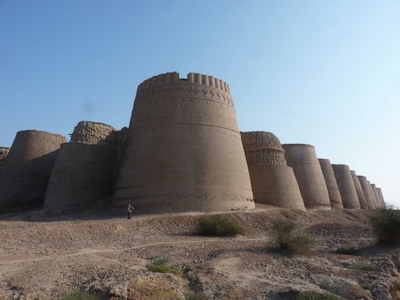Derawar and the Desert Forts of Cholistan

Derawar and the Desert Forts of Cholistan is part of the Tentative list of Pakistan in order to qualify for inclusion in the World Heritage List.
The Desert Forts of Cholistan are a serial proposal of up to a dozen medieval forts in south-eastern Pakistan, of which Derawan Fort is the best known and best preserved. This fortress network served to protect the caravan routes through the Cholistan desert. Derawar Fort is a large square fortress with a perimeter of 1500 metres. It has forty massive bastions with a height up to thirty metres.
Map of Derawar and the Desert Forts of Cholistan
Load mapThe coordinates shown for all tentative sites were produced as a community effort. They are not official and may change on inscription.
Community Reviews
Els Slots

The Desert Forts of Cholistan are a fairly recent addition to Pakistan’s Tentative List, so its potential OUV is better described than that of the earlier ones. The forts were built to enable and protect trade caravan routes and safeguard scarce water resources in the Cholistan desert, which is the western part of the Thar desert. The tentative site is identified as a Silk Road gap as it represents the 'transport' side of the Route instead of its outcomes.
I only visited Derawar Fort, the best-known and most iconic of these Desert Forts. Its perfect row of bastions was awarded with a Google Doodle already. This fort doesn’t lie deep into the desert: while driving up there (on a paved road), we saw sand to the left of the road only for the final kilometers and irrigated fields to the right. It’s also surrounded by a village.
Derawar Fort was built in the 9th century AD by a Hindu Rajput ruler, but its current form dates from the 18th century when it was used by the Muslim Nawabs of Bahawalpur. The exterior, with 40 bastions and impressively high walls, is the best-preserved part. It consists of clay bricks put together in decorative patterns. The last restorations were done in 2019 by Pakistani authorities.
The interior courtyard is the same mess as you’ll see at Lahore Fort or Rohtas Fort – everything is left to crumble, attracting graffiti and garbage. Only the prisoners’ cells and the hanging tower (photo 3) remain from the built structures (they date from the British period, who also seem to have left a cannon). In the far corner, there’s access to the living quarters (photo 2) of the former princely family, but these are closed nowadays and can only be visited after gaining prior permission from the Abbasi Family, as it is privately owned.
While I am still processing all the things I saw during my 12 days in Pakistan, Derawar Fort doesn’t stand out much in my memory and it certainly would need better conservation before becoming a WHS (the state of the 9 other desert forts of this serial site is even worse) as well as changes in ownership. When you visit Derawar, it's worth also entering the adjacent white marble mosque (Abbasi Masjid). It dates from the 1840s and was modelled after either the Moti Masjid in Delhi's Red Fort or the Moti Masjid at Lahore Fort. It’s a picturesque place, especially seen in combination with the exterior of the fort or from its walls.
Read more from Els Slots here.
Site Info
- Full Name
- Derawar and the Desert Forts of Cholistan
- Country
- Pakistan
- Added
- 2016
- Type
- Cultural
- Categories
- Structure - Military and Fortifications
- Link
- By ID
Site History
2016 Added to Tentative List
Site Links
Visitors
9 Community Members have visited.